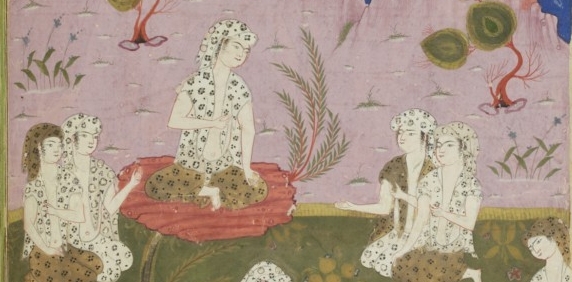
In Persian speaking regions of the historical Islamic world, the Shahnama (Book of Kings), an epic poem by the poet Firdawsi, was often richly illustrated. One such manuscript, Supplément Persan 490, is currently held in the Bibliothèque nationale de France (BnF) in Paris. Created in the first decade of the 17th century in Shiraz and Isfahan, Iran, the manuscript is one of many produced in the Safavid empire.
Below, you will find a collection of student digital multimedia work on select folios from the BnF Supplément Persan 490. Tap on the images below to play a short video about individual folios. To dig deeper, tap on the titles to open English translations of the episodes depicted. The folio numbers below will open the record in the BnF's online digital library Gallica.
Find out more about this project.
Cite this
Keshani, Hussein, ed. The Shahnama: A Digital Art History Student Project, Dec. 4, 2018. .
Each module also has its own citation information available on its title page.
Who?
In the fall of 2018, students enrolled in Dr. Hussein Keshani's course ARTH 370 - Art & Literature of the Islamic World at UBC Okanagan in Kelowna, Canada, were assigned the task of creating a multimedia web animation. They had to discuss an episode from the Shahnama using the Bibliothèque nationale de France's manuscript Supplément Persan 490. Most had no
knowledge of Persian art history or web programming!
The Shahnama (Book of Kings)
Perhaps the most famous work of Persian literature in history, the Shahnama is the longest poem composed by a single author - Firdawsi of Tus, Iran. He lived from 935 to around 1020 and authored the work under the Turco-Islamic Ghaznavid dynasty.
Firdawsi, a Persian Muslim, collected the oral and written pre-Islamic stories of Ancient Iran and distilled them into approximately 50,000 verses at a time when Persian culture lay in the shadow of earlier Arab conquests and Turkic rule. They tell the Persian version of humanity's origins, Persia's first kings, its mythical heroes, demons and creatures, its mythologized historical figures like Alexander the Great and Bahram Gur, and the advent of the Persian faith of Zoroastrianism.
From the early 14th to the 19th century, Persian elites delighted in commissioning expensive, illustrated versions of Shahnama manuscripts created by teams of artists and often used as gifts to impress and gain favour.
BnF Suppl. Persan 490
Formerly labelled Blochet 1171, the manuscript is thought to have been initially produced in Shiraz in 1604 and resumed in 1610 in Isfahan during the reign of Safavid emperor Shah Abbas (b. 1571 - d. 1629). It may have been taken to India and then to France sometime before 1830, but little else is known aside from the name of the calligrapher - Muḥammad Ğān Kirmānī. Of its 470 pages, 54 have paintings. The text is written in Persian Nastaliq calligraphy, with each page typically consisting of 30 lines divided into four columns.
The Shia Safavids continued the tradition of illustrating the Shahnama, producing some of the most expensive versions ever made. Shah Abbas was one of the dynasty's most successful emperors and famous for turning Isfahan into his capital with extraordinary architectural monuments. He was also a patron of the arts of the books, and illustrated manuscripts proliferated during his reign.
The titles for each of the folio paintings were taken from the Cambridge Shahnama Project, which differ from those used in the translation used in this project and from the French titles used in the BnF's Gallica website.
Learning Goals
The goals included improving abilities to observe visual works closely, read primary sources closely, and conduct focused secondary source research. In terms of communication, the goal was to enhance students abilities to communicate specialist material to a general audience in verbal, textual and visual ways. With regard to digital literacy, the goal was to familiarize students with basic web development and multimedia production.
Technical
The project uses HTML page and Javascript (with the GSAP library) templates developed by Keshani for the Evolving the Botanic Garden research project, an example of research being applied to the classroom. Students were trained in class on how to modify the templates in order to complete their project. The projects are actually compact web animations with soundtracks and not videos.